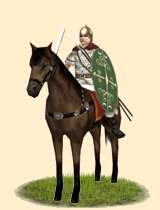Eqvites Thracvm (Thracian Auxiliary Cavalry)
 |
Weapons | Defence | Mental | ||||||
|---|---|---|---|---|---|---|---|---|---|
| Primary | Secondary | Armour: | 9 | Morale: | 11 | ||||
| Type: | spear | sword | Shield: | 3 | Discipline: | impetuous | |||
| Attack: | 6 | 9 | Skill: | 8 | Training: | trained | |||
| Charge: | 15 | 15 | Recruitment | Other | |||||
| Lethality: | 1 | 0.13 | Soldiers: | 25 | Hit Points: | 1 | |||
| Range: | 47.3 | 0 | Cost: | 2515 | Mass: | 1 | |||
| Ammo: | 6 | 0 | Upkeep: | 629 | |||||
| Turns: | 1 | ||||||||

The Thracian allies of the Res Publica field an excellent medium cavalry, that can now regularly be found in the armies of Roma. These horsemen are well suited for both missile and shock actions.
The Thracians field a versatile medium cavalry equipped for both, skirmishing and shock actions. Besides their swords, every rider carries several light javelins to skirmish with the enemy flank guards or simply weaken the enemy formations before the roman infantry engages or the Thracian horsemen charge to finish them. Compared to most Thracian cavalry, the well paid and supplied horsemen serving with our legions are equipped with considerably better gear. Most of their equites wear lorica squamata (scale mail) with iron scales and good quality bronze helmets. Additionally the Thracian fight with a large oval shield, rarely used by most nations' cavalrymen. Although these heavy shields are difficult to handle in most combat situations, and limit the use of the reigns, they have proved their enormous value in battle, by offering a vastly increased defence in close combat as well as against missile fire.
Together with other auxiliaries the Thracian horsemen give our legions the much needed effective cavalry support and are a worthy replacement for the roman equites of previous centuries.
Historically, various auxiliary cavalry completely replaced the Italic contingents in the roman armies of the late republic. During the late second century BC, Thrace and most of the Balkan peninsula came under roman dominance, although it stayed an independent client state and did not became a formal province unit 46 AD. In the last century of the republic, Thracian contingents made up of mostly cavalry, were often requested when a new roman army was raised and fought alongside it in campaigns throughout the Mediterranean world, from northern Africa to Asia and the Balkans.
Later, in the early Principate the Thracians had to supply the imperial army directly with recruits, in addition to the usual contingents sent by the Thracian king that still supported roman operations on the Balkan peninsula.
The continuous roman drafts caused some unrest and disturbance throughout Thrace, but despite these troubles the loyalty of the cohorts and alae thracum that were formed with these men remained unquestioned, and the Thracian soldiers in the auxilia made a far greater part of it than it would be expecter from their percentage in the empire's population. Probably through this recruitment practice the Thracian units still received the bulk of their replacements from their homeland while the majority of auxiliary soldiers were already recruited in their area of operation, they too changed to mainly local recruitment a few decades later in the first century AD.
Allied and subdued states and tribes always had to supply the roman army with troops. Almost at all times at least 50% of Roma’s soldiers were non-citizens. During the first centuries of the republic the old alae of the Italic socii were organized and equipped in a similar way to the roman legions, but around the beginning of the 1st century BC the situation changed. After the social war almost all the free people of Italia received roman citizenship and could now be recruited into the regular legions. In the decades after the “marian reforms” the roman light infantry disappeared. The ordo equester, having been unable for decades to provide a sufficient number of cavalry for the many wars the late republic had to fight, was split up in two main groups. A mainly political elite that filled out the numerous officer and administrative posts the ever growing Res Publica had to offer, and a pure economical elite, the large majority of the Roman and Italic equestrians.
The various different peoples now ruled by the republic were a much more heterogeneous group than the former Italic socii. Depending on their relative military strengths, they had to supply the roman army with the various troop types needed, besides heavy infantry, in order to be competitive on the battlefield.
Most of these troops were levied in the surrounding areas under roman control prior to campaign and only large scale or intesively prepared wars demanded additional forces and specialised units from distant areas of the Roman world. Many of the auxiliaries fought under their own chieftains and officers, while others, especially those recruited from regular provinces, were commanded by roman officers and even organized in roman manner. Usually the auxiliary units were disbanded and sent home after the end of a conflict. However, in the continuous wars during the last decades of the republic many served so long alongside the legions and fought for their generals that they were largely Romanized in the end.